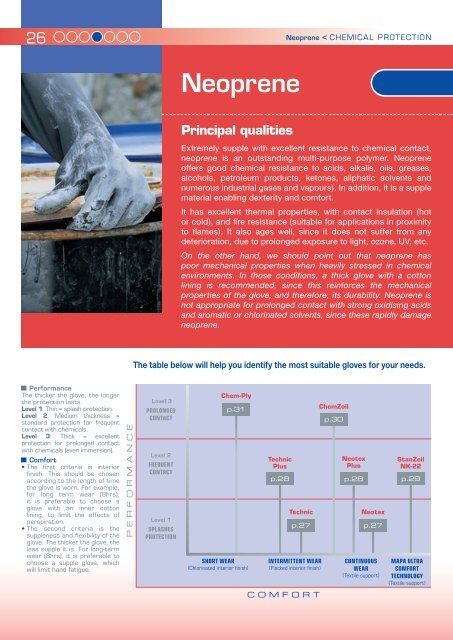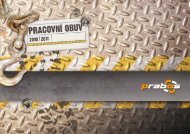MAPA Catalog - Blyth
MAPA Catalog - Blyth
MAPA Catalog - Blyth
You also want an ePaper? Increase the reach of your titles
YUMPU automatically turns print PDFs into web optimized ePapers that Google loves.
26<br />
Neoprene < Chemical Protection<br />
Neoprene<br />
Principal qualities<br />
Extremely supple with excellent resistance to chemical contact,<br />
neoprene is an outstanding multi-purpose polymer. Neoprene<br />
offers good chemical resistance to acids, alkalis, oils, greases,<br />
alcohols, petroleum products, ketones, aliphatic solvents and<br />
numerous industrial gases and vapours). In addition, it is a supple<br />
material enabling dexterity and comfort.<br />
It has excellent thermal properties, with contact insulation (hot<br />
or cold), and fire resistance (suitable for applications in proximity<br />
to flames). It also ages well, since it does not suffer from any<br />
deterioration, due to prolonged exposure to light, ozone, UV, etc.<br />
On the other hand, we should point out that neoprene has<br />
poor mechanical properties when heavily stressed in chemical<br />
environments. In those conditions, a thick glove with a cotton<br />
lining is recommended, since this reinforces the mechanical<br />
properties of the glove, and therefore, its durability. Neoprene is<br />
not appropriate for prolonged contact with strong oxidising acids<br />
and aromatic or chlorinated solvents, since these rapidly damage<br />
neoprene.<br />
The table below will help you identify the most suitable gloves for your needs.<br />
Performance<br />
The thicker the glove, the longer<br />
the protection lasts.<br />
Level 1: Thin = splash protection.<br />
Level 2: Medium thickness =<br />
standard protection for frequent<br />
contact with chemicals.<br />
Level 3: Thick = excellent<br />
protection for prolonged contact<br />
with chemicals (even immersion).<br />
Comfort<br />
• The first criteria is interior<br />
finish. This should be chosen<br />
according to the length of time<br />
the glove is worn. For example,<br />
for long term wear (8hrs),<br />
it is preferable to choose a<br />
glove with an inner cotton<br />
lining, to limit the effects of<br />
perspiration.<br />
• The second criteria is the<br />
suppleness and flexibility of the<br />
glove. The thicker the glove, the<br />
less supple it is. For long-term<br />
wear (8hrs), it is preferable to<br />
choose a supple glove, which<br />
will limit hand fatigue.<br />
Performance<br />
Level 3<br />
prolonged<br />
contact<br />
Level 2<br />
Frequent<br />
contact<br />
Level 1<br />
splashes<br />
Protection<br />
Chem-Ply<br />
p.31<br />
Short wear<br />
(Chlorinated interior finish)<br />
Technic<br />
Plus<br />
p.28<br />
Technic<br />
p.27<br />
Intermittent wear<br />
(Flocked interior finish)<br />
comfort<br />
ChemZoil<br />
p.30<br />
Neotex<br />
Plus<br />
p.28<br />
Neotex<br />
p.27<br />
Continuous<br />
wear<br />
(Textile support)<br />
StanZoil<br />
NK-22<br />
p.29<br />
Mapa Ultra<br />
comfort<br />
technology<br />
(Textile support)





